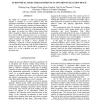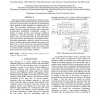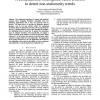324 search results - page 29 / 65 » Detecting spurious features using parity space |
ICMCS
2005
IEEE
14 years 2 months ago
2005
IEEE
The ability of a computer to detect and appropriately respond to changes in a user’s affective state has significant implications to Human-Computer Interaction (HCI). To more ac...
TIP
2008
13 years 8 months ago
2008
Abstract--This paper presents a new, simple, and efficient segmentation approach, based on a fusion procedure which aims at combining several segmentation maps associated to simple...
NN
2010
Springer
13 years 7 months ago
2010
Springer
The ratio of two probability density functions is becoming a quantity of interest these days in the machine learning and data mining communities since it can be used for various d...
ICASSP
2008
IEEE
14 years 3 months ago
2008
IEEE
This paper presents a hierarchical lane detection system with the ability to deal with both structured and unstructured roads. The proposed system classifies the environment first...
IJCNN
2006
IEEE
14 years 2 months ago
2006
IEEE
—The stationarity hypothesis is largely and implicitly assumed when designing classifiers (especially those for industrial applications) but it does not generally hold in practic...



